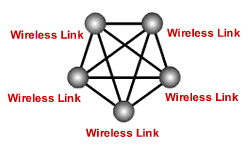Wireless mesh networks, as a wireless backhaul technology, provide scalability, redundancy and reliability. Fixed wireless mesh can be deployed on existing infrastructure, such as: buildings, traffic signals, and light poles, saving a lot of capital expenditures on the costs of mounting structures. Most outdoor wireless bridge radios that support wireless mesh networking operate in unlicensed wireless bands of 2.4GHz, 5.3GHz, 5.4GHz, 5.8GHz, or the 4.9GHz Public Safety band. There are several really good manufactures of wireless mesh equipment (Firetide, Proxim Wireless, FluidMesh, Azalea Networks, etc.).
In a wireless mesh network, outdoor wireless bridge links are made up of a wireless mesh node that can send and receive wireless backhaul IP traffic. Wireless mesh nodes can function as a router, wireless access point, or a wireless gateway device. Through the relaying process, a packet of wireless data will find its way to its destination, passing through intermediate links providing reliable wireless backhaul communication. If one mesh node can no longer operate, the other mesh nodes can still communicate with each other, directly or through one or more intermediate links. Wireless mesh nodes can communicate with one or more nodes and can determine the best wireless backhaul path to transmit its traffic or perform load balancing on the network.

Wireless mesh networks can be configured in a star topology or be made up of multiple types of configuration topologies such as: point to multipoint wireless backhaul or as a point to point wireless Ethernet bridge. Wireless mesh radios provide the ultimate flexibility from a single device.
Wireless mesh radio platforms have become a popular wireless Ethernet bridge architecture. Wireless mesh first became prevalent in the push for Municipal Wi-Fi applications by the wireless mesh manufactures and by Municipal governments trying to get notarized by offering wireless internet access to their communities. Municipal Wi-Fi was driven mostly by local politicians trying to boost their political clout with very little understanding on the actual outdoor wireless bridge technology. Many of these projects failed because of the lack of having a good business model to offer wireless internet access and in most cases little or no RF engineering was performed (wireless site survey, spectrum analysis, wireless network design, etc.). Making matters worse many manufactures were guilty of over marketing the capabilities of their products (how many wireless mesh nodes that could be deployed before having to have a backhaul to avoid high latency and maintain adequate throughput on the networks) and by not educating their clients on the of potential wireless interference when using unlicensed wireless backhaul.
Many municipal agencies consulted their hardware manufacture, which understand their equipment, but do not have actual experience in deploying outdoor wireless Ethernet bridges, nor should they. They are manufactures not wireless installation services companies. As many Municipal agencies soon found out that the cost was more than anticipated as they were told that to solve any connectivity issues they needed to just add more devices.
The wireless mesh hardware platform was not the issue. The problem was the lack of proper RF planning (performing proper wireless site survey and spectrum analysis), wireless network design, and proper wireless installation. Wireless mesh is a good topology but as with any outdoor wireless backhaul it needs to be done by experienced wireless integrators.
Recently, fixed wireless mesh has found a new niche market to serve. The growth of outdoor IP video surveillance has made wireless mesh a cost effective solution. Mesh, as an outdoor wireless bridge technology, provides the ultimate scalability and flexibility in network design. Wireless video networks can be scaled over time and wireless backhaul using mesh can allow cameras to be placed almost anywhere. Manufactures like Firetide, Proxim, and Fluidmesh were early adopters by optimizing their wireless mesh platform for video backhaul and have done a good job marketing to the IP video marketplace.





